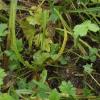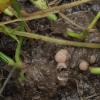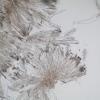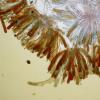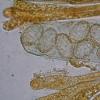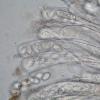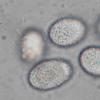
25-11-2016 13:54
 Stephen Martin Mifsud
Stephen Martin Mifsud
Hi, I found numerous seeds of Washingtonia robusta

28-10-2025 22:22
 Bernard Declercq
Bernard Declercq
Hello.I'm searching for the following paper:Punith

28-10-2025 19:33
 Nicolas Suberbielle
Nicolas Suberbielle
Bonjour à tous,Je voudrais votre avis sur cette r

28-10-2025 15:37
Carl FarmerI'd be grateful for any suggestions for this strik

28-10-2025 11:29
 Tanja Böhning
Tanja Böhning
Hello, I found this very small (ca 0,5mm) yellow

27-10-2025 00:34
 Francois Guay
Francois Guay
I found this strange species in Québec,Canada, gr

27-10-2025 15:29
 Michel Hairaud
Michel Hairaud
Bonjour à tous, Avec Elisabeth Stöckli nous avo
Iodophanus ou Thecotheus?
Piet BORMANS,
27-11-2010 12:24
 Bonjour.
Bonjour. Une collègue m'a transmise cette question:
On the edge of a burned place; probably on rotten organic material or fimicole
Apothecia solitary and gregarious
Macro: Fruitbody 1mm - 3mm diameter, 1 mm high, soft fleshy, sessile, light rose, watery rose, flesh-color with lila shade
Disc- to lensform when young. Hemisphaerical, pulvinate when fully developed.
Asci standing out the fruitbody.
Micro
Asci: operculate, 8 sp, biseriat, the top not rounded but somewhat angular, 259-331x33-40 µm
sp: 22-27x 15-17 µm (Q 1.35-1.69)broad ellipsoid, densely fine warty, hyaline, without oildrops, young spores in individually rounded little bags. Ejaculated spores seems to stay together (sticky covering?)
Reaction in Melzer ( the same reaction in Lugol): J+; amyloid,very dark red; wall and top of the asci blue;
Paraphyses: with 5 to 7 septes; straight to light curved, not furcated. Upperpart with oliv-bluegreen guttules(none orange guttules observed, none red pigment in the droplets), centrally situated mass in the remaining parts of the paraphyses except the upperpart. Gradually broadened to the top. Lower part 4-8 (9.5) µm wide), top 10-13(16) µm wide.
Excipulum with lila droplets
René Dougoud,
27-11-2010 14:07
Re:Iodophanus ou Thecotheus?
Cher Collègue,
Il s'agit sans doute de Iodophanus carneus (Pers.) Korf
Je ne dispose que de peu de temps pour vous répondre, j'y reviendrai donc ultérieurement ! Merci de votre compréhension. Mais sans doute que d'autres collègues vous répondront !
Cordialement
René
Il s'agit sans doute de Iodophanus carneus (Pers.) Korf
Je ne dispose que de peu de temps pour vous répondre, j'y reviendrai donc ultérieurement ! Merci de votre compréhension. Mais sans doute que d'autres collègues vous répondront !
Cordialement
René
Ron Bronckers,
27-11-2010 14:28
Re:Iodophanus ou Thecotheus?
Hello Piet,
Most likely an Iodophanus species because no species of Thecotheus matches your description
According to the key in Doveri (2004) it could be the non-coprophilous Iodophanus verrucosporus (P.W. Graff) Kimbr., Luck-Allen & Cain (1969) which has spores 22-27 x 14-16, broadly ellipsoid and finely warted, but the colour of the apothecia should be brownish.
Remarkable is the fact that Elshafie reports this species as coprophilous (http://mycotaxon.com/resources/checklists/elshafie-v93-checklist.pdf).
Perhaps you should try to get hold of the description by Luck-Allen & Cain (1969) in Am. J. Bot. 56(10): 1199.
With kind regards,
Ron Bronckers
Most likely an Iodophanus species because no species of Thecotheus matches your description
According to the key in Doveri (2004) it could be the non-coprophilous Iodophanus verrucosporus (P.W. Graff) Kimbr., Luck-Allen & Cain (1969) which has spores 22-27 x 14-16, broadly ellipsoid and finely warted, but the colour of the apothecia should be brownish.
Remarkable is the fact that Elshafie reports this species as coprophilous (http://mycotaxon.com/resources/checklists/elshafie-v93-checklist.pdf).
Perhaps you should try to get hold of the description by Luck-Allen & Cain (1969) in Am. J. Bot. 56(10): 1199.
With kind regards,
Ron Bronckers
Ron Bronckers,
27-11-2010 14:42
Re:Iodophanus ou Thecotheus?
Dear Piet,
To be more precise concerning the publication:
Kimbrough J.W., Luck-Allen E.R. & Cain R.F. (1969) - Iodophanus, the pezizae segregate of Ascophanus (Pezizales). American Journal of Botany 56(10): 1187-1202.
Perhaps one of the readers can help you.
Good luck!
Ron
To be more precise concerning the publication:
Kimbrough J.W., Luck-Allen E.R. & Cain R.F. (1969) - Iodophanus, the pezizae segregate of Ascophanus (Pezizales). American Journal of Botany 56(10): 1187-1202.
Perhaps one of the readers can help you.
Good luck!
Ron
Michel Delpont,
27-11-2010 14:53

Re:Iodophanus ou Thecotheus?
Salut Piet.
Au vu des photos et des réactions je pense également comme René et Ron au genre Iodophanus.
Carneus peut être très variable tant au point de vue des couleurs que de l'ornementation des spores; mais il s'agit sans doute là d'une autre espèce, les spores et les asques étant nettement plus grand.
Je connais très peu ce genre, et Ron a certainement raison de suggérer Iodophanus verrucosporus, qui semble correspondre à la description.
Cordialement.
Michel.
Au vu des photos et des réactions je pense également comme René et Ron au genre Iodophanus.
Carneus peut être très variable tant au point de vue des couleurs que de l'ornementation des spores; mais il s'agit sans doute là d'une autre espèce, les spores et les asques étant nettement plus grand.
Je connais très peu ce genre, et Ron a certainement raison de suggérer Iodophanus verrucosporus, qui semble correspondre à la description.
Cordialement.
Michel.
Piet BORMANS,
28-11-2010 16:19

Re:Iodophanus ou Thecotheus?
Merci beaucoup à Michel et René pour vos réponses et j'attendrais avec plaisir le moment ou René reviendra sur le sujet.
Amicalement, Piet
Also many thanks to Ron and as he suggested: is there maybe someone who can provide me this article?
Kind regards, Piet
Amicalement, Piet
Also many thanks to Ron and as he suggested: is there maybe someone who can provide me this article?
Kind regards, Piet
René Dougoud,
01-12-2010 10:01
Re:Iodophanus ou Thecotheus?
Cher Collègue,
Je reviens à votre demande. Je suis persuadé qu'il s'agit d'une espèce du genre Iodophanus, mais je dois avouer que, pressé, je métais avancé en laissant penser qu'il pouvait s'agir de I. carneus. Les ascospores de cette dernière espèce étant trop petites, comparées à celles que vous avez mesurées. Comme indiqué plus haut, il conviendrait, si cela n'avait été fait, de consulter le travail de Doveri. Je pense qu'une observation des ascospores dans le bleu coton et à l'immersion vous faciliterait l'appréciation de l'ornementation et de fait la détermination.
Bien amicalement
René
Je reviens à votre demande. Je suis persuadé qu'il s'agit d'une espèce du genre Iodophanus, mais je dois avouer que, pressé, je métais avancé en laissant penser qu'il pouvait s'agir de I. carneus. Les ascospores de cette dernière espèce étant trop petites, comparées à celles que vous avez mesurées. Comme indiqué plus haut, il conviendrait, si cela n'avait été fait, de consulter le travail de Doveri. Je pense qu'une observation des ascospores dans le bleu coton et à l'immersion vous faciliterait l'appréciation de l'ornementation et de fait la détermination.
Bien amicalement
René
Piet BORMANS,
01-12-2010 21:09

Re:Iodophanus ou Thecotheus?
Bonsoir René.
Merci pour votre commentaire. Nous avons vérifié le travail (et la clé) de Doveri ainsi qu’un travail de Uwe Lindemann et Dirk Wieschollek, publié à « Tintling » en 2009.
Nous espérons encore pouvoir consulter la publication de « Kimbrough J.W., Luck-Allen E.R. & Cain R.F. (1969) - Iodophanus, the pezizae segregate of Ascophanus (Pezizales). American Journal of Botany 56(10): 1187-1202”.
Nous sommes convaincus qu’il s’agit de Iodophanus verrucosporus.
Bien amicalement
Piet
Merci pour votre commentaire. Nous avons vérifié le travail (et la clé) de Doveri ainsi qu’un travail de Uwe Lindemann et Dirk Wieschollek, publié à « Tintling » en 2009.
Nous espérons encore pouvoir consulter la publication de « Kimbrough J.W., Luck-Allen E.R. & Cain R.F. (1969) - Iodophanus, the pezizae segregate of Ascophanus (Pezizales). American Journal of Botany 56(10): 1187-1202”.
Nous sommes convaincus qu’il s’agit de Iodophanus verrucosporus.
Bien amicalement
Piet

